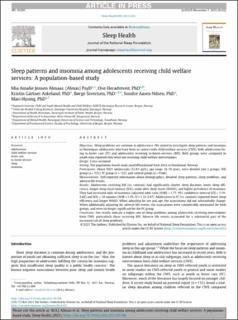| dc.description.abstract | Objectives
Sleep problems are common in adolescence. We aimed to investigate sleep patterns and insomnia in Norwegian adolescents who have been in contact with child welfare services (CWS), both adolescents living in foster care (FC) and adolescents receiving in-home-services (IHS). Both groups were compared to youth who reported they were not receiving child welfare interventions.
Design
Cross-sectional.
Setting
The population-based study youth@hordaland from 2012 in Hordaland, Norway.
Participants
About 9421 adolescents (53.8% girls), age range 16-19 years, were divided into 3 groups; IHS group (n = 123), FC group (n = 132), and control group (n = 9166).
Measurements
Self-reported information about demographics, detailed sleep patterns, sleep problems, and adverse life events.
Results
Adolescents receiving IHS (vs. controls) had significantly shorter sleep duration, lower sleep efficiency, longer sleep onset latency (SOL), wake after sleep onset (WASO), and higher prevalence of insomnia. They had increased odds of insomnia (adjusted odds ratio [AOR] = 1.77, 95% confidence interval [CI] = 1.19-2.62) and SOL ≥ 30 minutes (AOR = 1.95, CI = 1.32-2.87). Adolescents in FC (vs. controls) reported lower sleep efficiency and longer WASO. When adjusting for sex and age, the associations did not substantially change. When additionally adjusting for adverse life events, the associations were considerably attenuated for both groups, and were no longer significant for the FC group.
Conclusion
Our results indicate a higher rate of sleep problems among adolescents receiving interventions from CWS, particularly those receiving IHS. Adverse life events accounted for a substantial part of the increased risk of sleep problems. | en_US |

